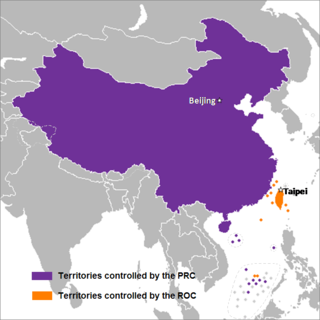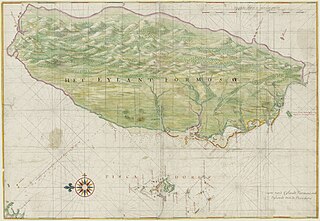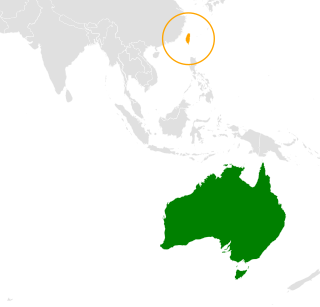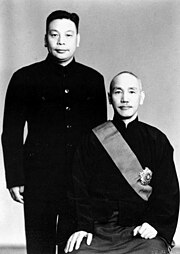
Chinese unification, also known as Cross-Strait unification or Chinese reunification, is the potential unification of territories currently controlled, or claimed, by the People's Republic of China and the Republic of China ("Taiwan") under one political entity, possibly the formation of a political union between the two republics. Together with full Taiwan independence, unification is one of the main proposals to address questions on the political status of Taiwan, which is a central focus of Cross-Strait relations.
The controversy surrounding the political status of Taiwan or the Taiwan issue is an ongoing dispute on the political status of Taiwan, currently controlled by the Republic of China (ROC). This dispute arose in the mid-twentieth century.
The term One China may refer, in alphabetical order, to one of the following:

The Treaty of San Francisco, also called the Treaty of Peace with Japan, re-established peaceful relations between Japan and the Allied Powers on behalf of the United Nations by ending the legal state of war and providing for redress for hostile actions up to and including World War II. It was signed by 49 nations on 8 September 1951, in San Francisco, California, at the War Memorial Opera House. Italy and China were not invited, the latter due to disagreements on whether the Republic of China or the People's Republic of China represented the Chinese people. Korea was also not invited due to a similar disagreement on whether South Korea or North Korea represented the Korean people.

The Joint Communiqué of the United States of America and the People's Republic of China, also known as the Shanghai Communiqué (1972), was a diplomatic document issued by the United States of America and the People's Republic of China on February 27, 1972, on the last evening of President Richard Nixon's visit to China.

As a result of the surrender and occupation of Japan at the end of World War II, the islands of Taiwan and Penghu were placed under the governance of the Republic of China (ROC), ruled by the Kuomintang (KMT), on 25 October 1945. Following the February 28 massacre in 1947, martial law was declared in 1949 by the Governor of Taiwan, Chen Cheng, and the ROC Ministry of National Defense. Following the end of the Chinese Civil War in 1949, the ROC government retreated from the mainland as the Chinese Communist Party (CCP) proclaimed the establishment of the People's Republic of China. The KMT retreated to Taiwan and declared Taipei the temporary capital of the ROC. For many years, the ROC and PRC each continued to claim in the diplomatic arena to be the sole legitimate government of "China". In 1971, the United Nations expelled the ROC and replaced it with the PRC.

The United Nations General Assembly Resolution 2758 was passed in response to the United Nations General Assembly Resolution 1668 that required any change in China's representation in the UN be determined by a two-thirds vote referring to Article 18 of the UN Charter. The resolution, passed on 25 October 1971, recognized the People's Republic of China as "the only legitimate representative of China to the United Nations" and removed "the representatives of Chiang Kai-shek" from the United Nations.

The Sino-Japanese Peace Treaty, formally the Treaty of Peace between the Republic of China and Japan and commonly known as the Treaty of Taipei, was a peace treaty between Japan and the Republic of China (ROC) signed in Taipei, Taiwan on 28 April 1952, and took effect on August 5 the same year, marking the formal end of the Second Sino-Japanese War (1937–1945).

Since its founding in 1949, the People's Republic of China (PRC) has had a diplomatic tug-of-war with its rival in Taiwan, the Republic of China (ROC). Throughout the Cold War, both governments claimed to be the sole legitimate government of all China and allowed countries to recognize either one or the other. Until the 1970s, most Western countries in the Western Bloc recognized the ROC while the Eastern Bloc and Third World countries generally recognized the PRC. This gradually shifted and today only 11 UN member states recognize the ROC while the PRC is recognized by the United Nations, as well as 181 UN member states, Cook Islands, Niue and the State of Palestine. Both the ROC and the PRC maintain the requirement of recognizing its view of the One China policy to establish or maintain diplomatic relations.

The 1972 visit by United States president Richard Nixon to the People's Republic of China was an important strategic and diplomatic overture that marked the culmination of the Nixon administration's establishment of relations between the United States of America and the People's Republic of China after years of American diplomatic policy that favored the Republic of China in Taiwan. The seven-day official visit to three Chinese cities was the first time a U.S. president had visited the PRC; Nixon's arrival in Beijing ended 25 years of no communication or diplomatic ties between the two countries and was the key step in normalizing relations between the U.S. and the PRC. Nixon visited the PRC to gain more leverage over relations with the Soviet Union, following the Sino-Soviet split. The normalization of ties culminated in 1979, when the U.S. established full diplomatic relations with the PRC.

The Joint Communiqué on the Establishment of Diplomatic Relations of January 1, 1979, established official relations between the United States and the People's Republic of China.

The complex relationship between Japan and Taiwan dates back to 1592 during the Sengoku period of Japan when the Japanese ruler Toyotomi Hideyoshi sent an envoy named Harada Magoshichirou to the Takasago Koku 高砂国 (Taiwan). The bilateral trading relations continued through the Dutch colonial rule and the Tungning Kingdom of Taiwan in 17th century before the completion of Japan's Sakoku policy. After the Meiji restoration in latter half of the 19th century, Japan resumed its expansionist ambition upon Taiwan and successfully annexed Taiwan under Japanese rule from 1895 to 1945, until the surrender of Japan after World War II. Taiwan was also surrendered by Japan to the Republic of China on 25 October 1945.

China–Japan relations or Sino-Japanese relations are the bilateral relations between China and Japan. The countries are geographically separated by the East China Sea. Japan has been strongly influenced throughout its history by China, especially by the East and Southeast through the gradual process of Sinicization with its language, architecture, culture, cuisine, religion, philosophy, and law. When Japan was forced to open trade relations with the West after the Perry Expedition in the mid-19th century, Japan plunged itself through an active process of Westernization during the Meiji Restoration in 1868 and began viewing China under the Qing dynasty as an antiquated civilization unable to defend itself against foreign forces—in part due to the First and Second Opium Wars along with the Eight-Nation Alliance's involvement in suppressing the Boxer Rebellion. Japan eventually took advantage of such weaknesses by invading China, including the First Sino-Japanese War and the Second Sino-Japanese War.

The bilateral relations between India and Taiwan have improved since the 1990s, despite both nations not maintaining official diplomatic relations. India recognises only the People's Republic of China and not the Republic of China's claims of being the legitimate government of Mainland China, Hong Kong, and Macau - a conflict that emerged after the Chinese Civil War (1945–49). However, India's economic and commercial links as well as people-to-people contacts with Taiwan have expanded in recent years.

Russia–Taiwan relations or Taiwan–Russia relations are the bilateral foreign relations between Taiwan and Russia. Due to the 2022 Russian invasion of Ukraine, relations became tense after Taiwan imposed sanctions against Russia. Russia placed Taiwan on a list of "unfriendly countries", along with South Korea, Japan, Singapore, the United States, European Union members, NATO members, Canada, Australia, New Zealand, Norway, Switzerland, Micronesia and Ukraine.
Project Guoguang was an attempt by the Republic of China (ROC), based in Taiwan, to reconquer mainland China from the People's Republic of China (PRC) by large scale invasion. It was the most elaborate of the ROCs plans or studies to invade the mainland after 1949. Guoguang was initiated in 1961 in response to events involving the PRC, particularly the Great Leap Forward, the Sino-Soviet split, and the development of nuclear weapons. Guoguang was never executed; it required more troops and material than the ROC could muster, and it lacked support from the United States. The use of a large scale invasion as the initial stage of reunification was effectively abandoned after 1966, although the Guoguang planning organization was not abolished until 1972. The ROC did not abandon the policy of using force for reunification until 1990.
With the establishment of the People's Republic of China in 1949, American immigration policy towards Chinese emigrants and the highly controversial subject of foreign policy with regard to the PRC became invariably connected. The United States government was presented with the dilemma of what to do with two separate "Chinas". Both the People's Republic of China and the Republic of China wanted be seen as the legitimate government and both parties believed that immigration would assist them in doing so.

Relations between the Commonwealth of Australia and the Republic of China, formerly the Qing dynasty, date back to 1909. Since 1972, the political status and legal status of Taiwan have been contentious issues. Australia and Taiwan share partnership in the inter-governmental Global Cooperation and Training Framework (GCTF) activities.

The retreat of the government of Republic of China to Taiwan, also known as the Kuomintang's retreat to Taiwan or the Great Retreat in Taiwan, refers to the exodus of the remnants of the then-internationally-recognized Kuomintang-ruled government of the Republic of China (ROC) to the island of Taiwan (Formosa) on December 7, 1949, after losing the Chinese Civil War in the Chinese mainland. The Kuomintang, its officers, and approximately 2 million ROC troops took part in the retreat, in addition to many civilians and refugees, fleeing the advance of the People's Liberation Army of the Chinese Communist Party (CCP). The CCP, who now effectively controlled most of Mainland China, spent the subsequent years purging any remnant Nationalist agents and bandits in western and southern China, solidifying the rule of the newly established People's Republic of China.
The Japan–China Trade Agreement of 1974 served as a continuation of various treaties between the People's Republic of China (PRC) and Japan during the Cold War. The treaty was an important step in the normalization of relations between China and Japan, after diplomatic and economic ties had been formally re-established via the 1972 Japan–China Joint Communiqué. The talks were headed by China's Minister of External Trade and eventual Premier, Zhou Enlai (1898–1976), and Japan's Prime Minister, Tanaka Kakuei (1918–1993). The treaty was successful due to China's road to internationalism after 1972, followed by a series of diplomatic treaties, such as the Japan-China Aviation Pact, the Maritime Agreement, the Fisheries Agreement, and the Trade Mark Protection Agreement, concluding with the official Japan-China Peace and Friendship Treaty of August 1978.






















